Gajar Ka Halwa, also known as Carrot Halwa, is the quintessential Indian dessert that brings nostalgia and celebration to every bite. Made with grated carrots, milk, ghee, sugar, khoya (mawa), and a generous sprinkle of nuts, this indulgent sweet treat is a festival favorite in Indian homes, especially during Diwali, Holi, and winter celebrations.
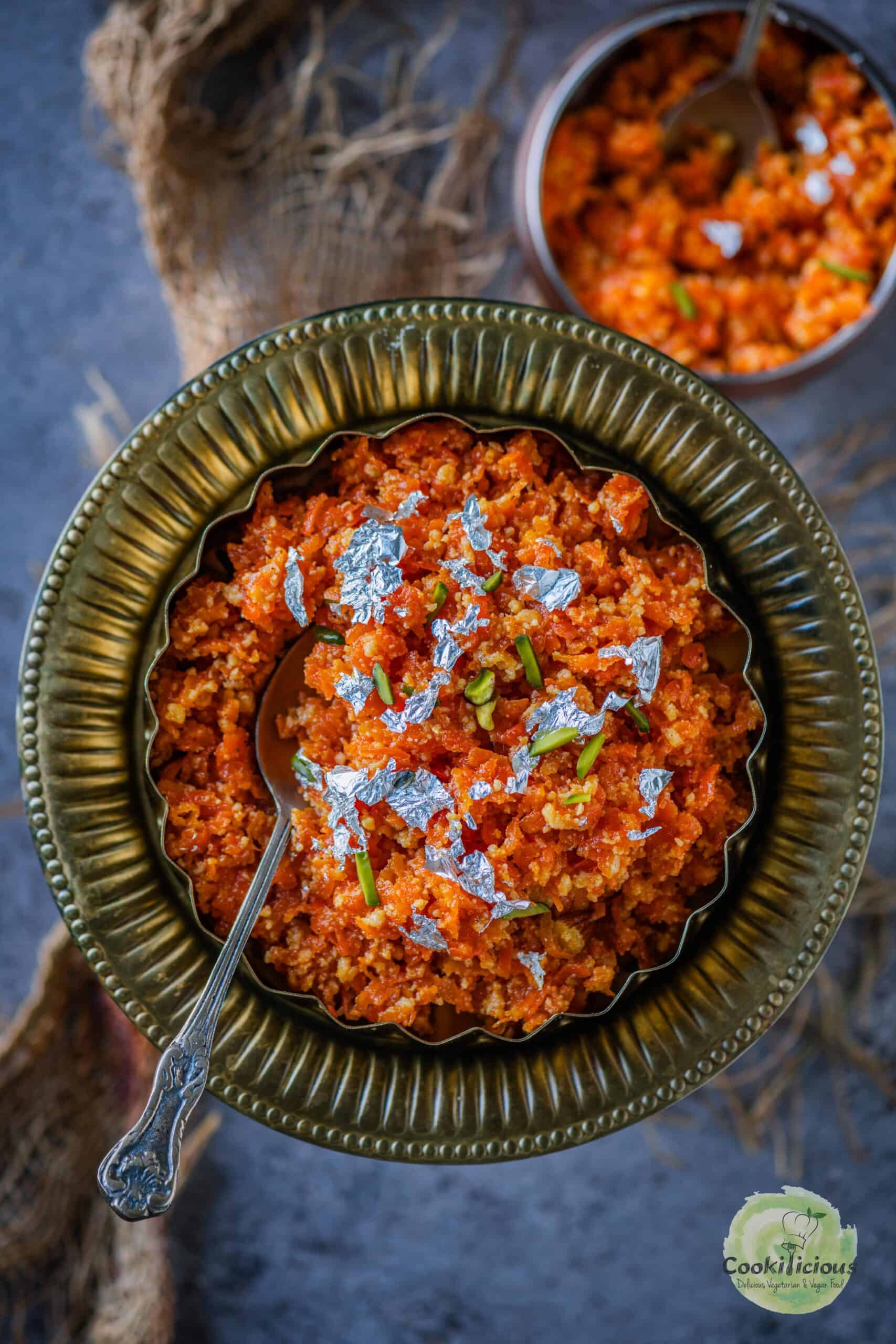
Jump to:
🥕 What Is Gajar Ka Halwa
Gajar ka Halwa, also known as Carrot Halwa or Gajrela, is a beloved North Indian and Pakistani dessert made by slowly cooking grated red carrots with milk, ghee, sugar, and khoya (mawa). This decadent treat is often made during festivals like Diwali, Holi, weddings, and winter gatherings.
Traditionally, red Delhi carrots are used for their natural sweetness and vibrant color, but orange carrots work well too. This Indian carrot pudding is right up there with Seviyan Kheer, and Rice Kheer as one of the most cherished Indian desserts made on festive occasions.
Whether you call it gajar halwa, carrot ka halwa, or Indian carrot dessert, this sweet dish recipe is a popular Indian dessert that's a favorite across households. It's naturally gluten-free, eggless, and vegetarian. While there are many ways to prepare this Indian halwa recipe - with khoya, mawa, milkmaid, or even ricotta cheese - this post focuses on an easy, homemade version made without condensed milk.
In this post, I'm sharing my mom's delicious Gajar ka Halwa recipe that's authentic, rich, and creamy. This version uses the microwave for convenience and speed, but it can easily be adapted for the stovetop or Instant Pot.
If you follow a plant-based diet, check out my Vegan Carrot Halwa recipe made in the Instant Pot-it's a lighter yet flavorful version. You might also enjoy my Beetroot Halwa, a colorful twist on the classic that's just as festive and delicious.
❤️ A Sweet Slice of Nostalgia
Growing up, Amma's Gajar ka Halwa was the heart of our Diwali celebrations. She would patiently slow-cook grated carrots with milk, ghee, and sugar, filling our home with the rich aroma of this traditional Indian carrot dessert.
The year we got a microwave, everything changed. Her signature Carrot Halwa came together in a fraction of the time, yet retained its authentic, creamy texture. A warm casserole dish would sit on the dining table, slowly disappearing spoonful by spoonful.
Gajjar Halwa was also the first Indian dessert I made on my own. When it turned out just like Amma's-rich, creamy, and full of love-I knew I had captured a little piece of home.
⚡ Why Make Gajar ka Halwa in the Microwave
Making Carrot Halwa in the microwave is truly a game-changer! This quick and efficient method gives you all the rich, traditional flavors of classic Gajar ka Halwa-without standing over the stove for hours.
✅ Great for small batches - Ideal when you're craving something sweet without committing to a large pot.
✅ Faster cooking time - Perfect for busy days or last-minute festive prep.
✅ Fewer dishes, less mess - Everything cooks in one microwave-safe bowl.
✅ Hands-free and hassle-free microwave dessert - No constant stirring, just set a timer and stir occasionally.
I also love using the microwave for Indian desserts like my Vegan Sweetcorn Pudding, so if you enjoy shortcuts that don't skimp on flavor, you'll love this tasty microwave Gajar ka Halwa with Khoya recipe!
Why Make It
- Quick and easy microwave halwa ⚡
- Beginner-friendly dessert recipe
- Authentic flavor-just like mom made it 👩🍳💖
- Perfect for Diwali, Holi, weddings, or any celebration 🎉🪔💍
- Can be made with any variety of carrots 🥕🌈
- Naturally vegetarian and gluten-free 🌱🚫🌾
Ingredients Needed 🧾
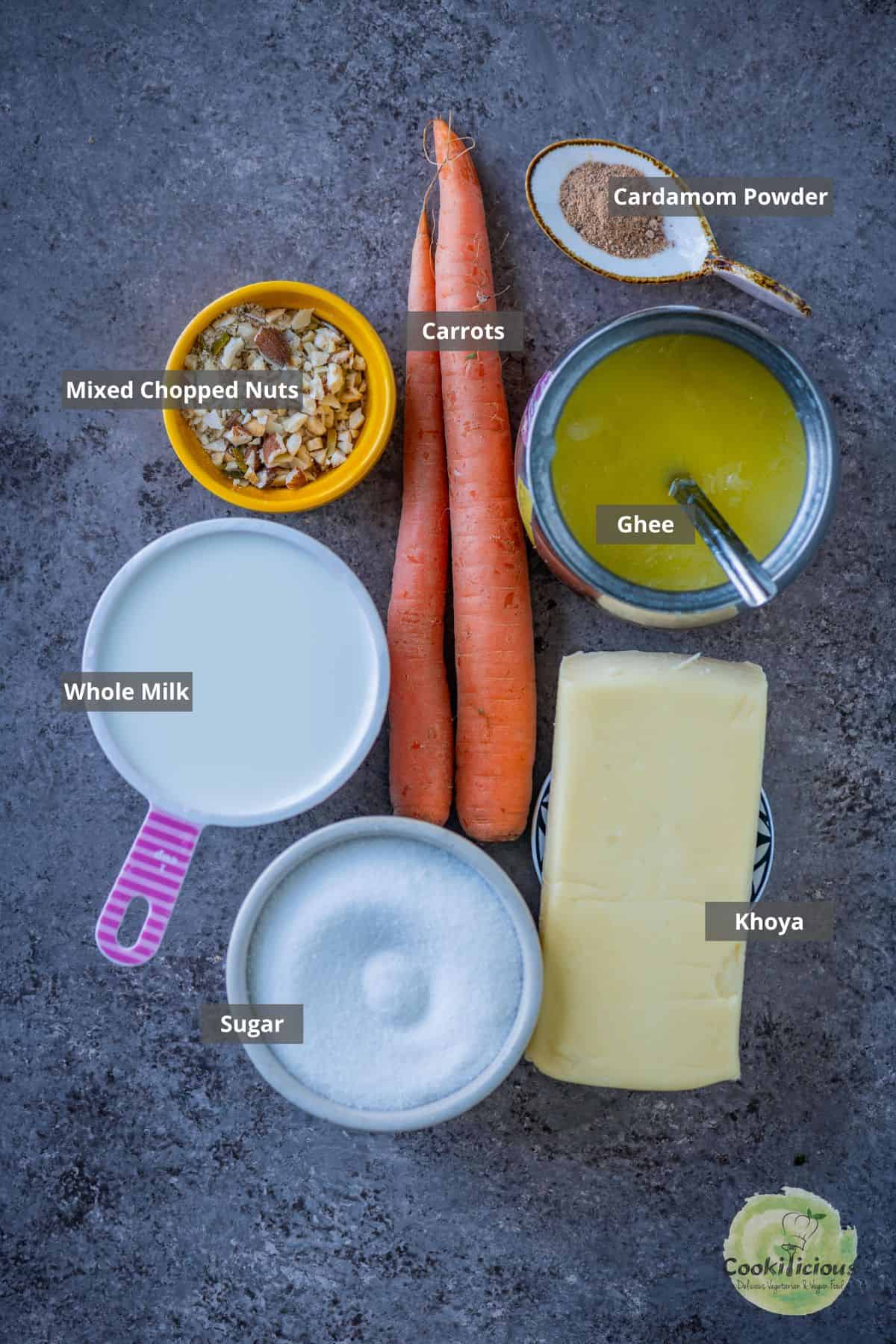
Carrots: Preferably use thin red Delhi carrots for their natural sweetness and vibrant color. In the US, check stores like Sprouts, Whole Foods, or Fresh Market for organic red carrots. If unavailable, orange carrots will work-just adjust the sugar accordingly. Precut grated carrots can be used but may be less moist.
Tip: Don't let the extra carrots go to waste-use them to make my Carrot Oats Dosa or refreshing Carrot Orange Juice.
Milk: Full-fat milk works best for richness and helps give that creamy consistency. For a dairy-free version, check out my Vegan Carrot Halwa recipe.
Khoya (Mawa): This is the soul of an authentic Carrot Halwa with Khoya. It adds a luscious, slightly grainy texture that makes every bite indulgent. You can buy khoya at any Indian grocery store or make it at home using milk powder.
Ghee: Don't skip the pure desi ghee-it adds unmatched flavor and aroma, essential for a true Indian mithai experience. Butter is an option, but ghee is preferred.
Sugar: Use regular white sugar and adjust to taste. You can also swap in sweetened condensed milk for extra richness, especially when making a microwave Carrot Halwa.
Nuts: A mix of chopped pistachios, almonds, and cashews adds texture and a festive crunch. Fry them in ghee before mixing them in for more depth.
Aromatics: A generous pinch of cardamom powder and a few strands of saffron (soaked in warm milk) infuse the dessert with warmth and floral sweetness, typical of many traditional Indian sweets.
Silver Vark - This is optional. Vark (or varak) is an ultra-thin, edible silver foil used to decorate Indian sweets like Kaju Katli, laddoos, and burfi, especially during festivals and weddings.💡 Tip: Always buy food-grade vark from a trusted source.
How To Make It 🔪
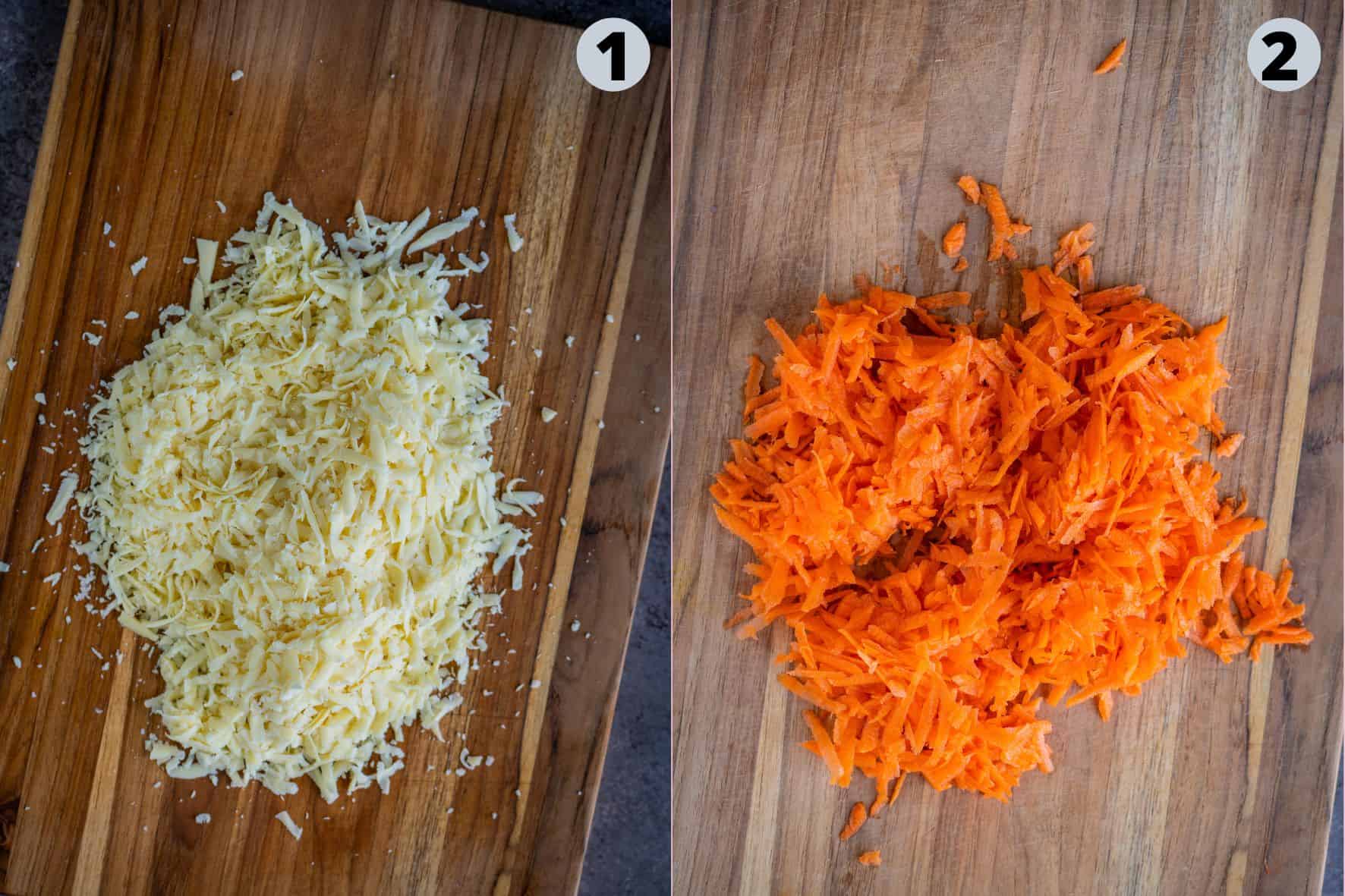
- Grate the khoya (mawa) and set it aside. This helps it melt evenly into the mixture, giving you that luscious, grainy texture typical of a traditional Carrot Halwa recipe.
- Peel and grate the carrots using a thick hand grater. Avoid using a very fine grater-it tends to make the halwa mushy. For large batches, use a food processor to grate the carrots quickly and uniformly.
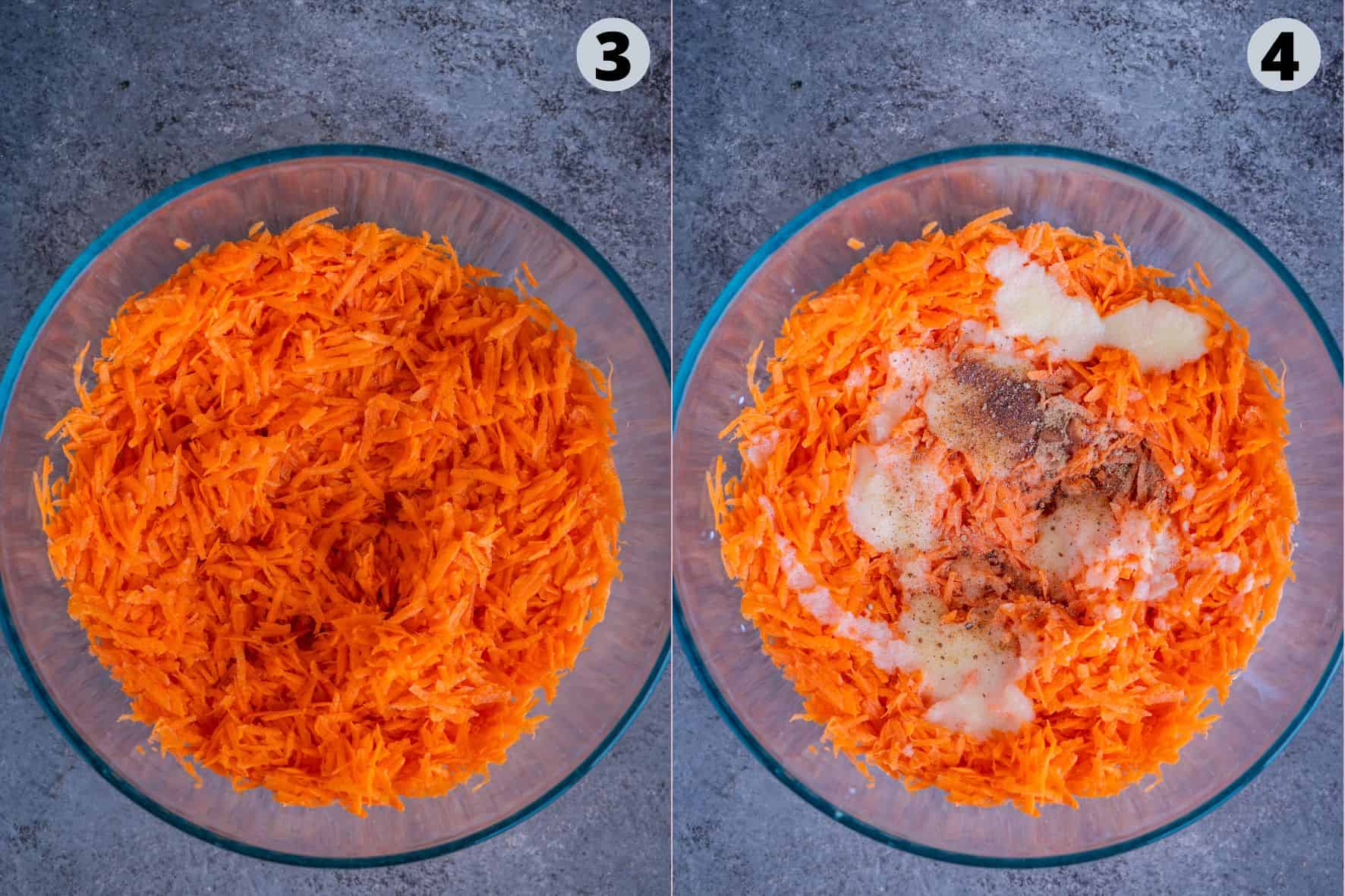
- Transfer the grated carrots to a large microwave-safe bowl-make sure it's deep enough to allow for bubbling and stirring without any messy spills.
- Add ghee, full-fat milk (at room temperature), and a pinch of cardamom powder for that classic aroma. Mix everything well so the carrots are evenly coated-this step is key to getting a balanced, rich flavor in your microwave carrot halwa. Microwave the mixture on HIGH in 5-minute intervals (total 15 minutes), stirring after each interval with a heat-safe silicone spatula. This ensures the carrots cook evenly and don't stick or burn. ⚠️ Safety Tip: The bowl will get hot-always use pot holders or a kitchen towel when removing it from the microwave.

Want to save this recipe?
- After the initial 15 minutes, your grated carrots should be soft, and most of the milk would have evaporated. If you still see too much moisture, microwave for another 5 minutes, checking and stirring every couple of minutes.
- Now it's time to add the sugar-this is when your kitchen starts to smell like a festival! Mix the sugar in thoroughly and microwave on HIGH for 3 more minutes, stirring once midway through. The Gajar ka Halwa may appear a bit runny at this stage, but don't worry-the sugar releases moisture that will slowly reduce and thicken as it cools.

- After the 3-minute mark, don't panic if your mixture still looks a little liquid-that's completely normal!
- Now, add the grated or crumbled khoya to the bowl. Mix it in thoroughly so it begins to melt evenly into the mixture. Microwave on HIGH for another 10 minutes, stirring once at the halfway point. This step is key: the khoya melts into the halwa, transforming it into that creamy carrot halwa with a rich, grainy texture that defines this traditional Indian dessert.
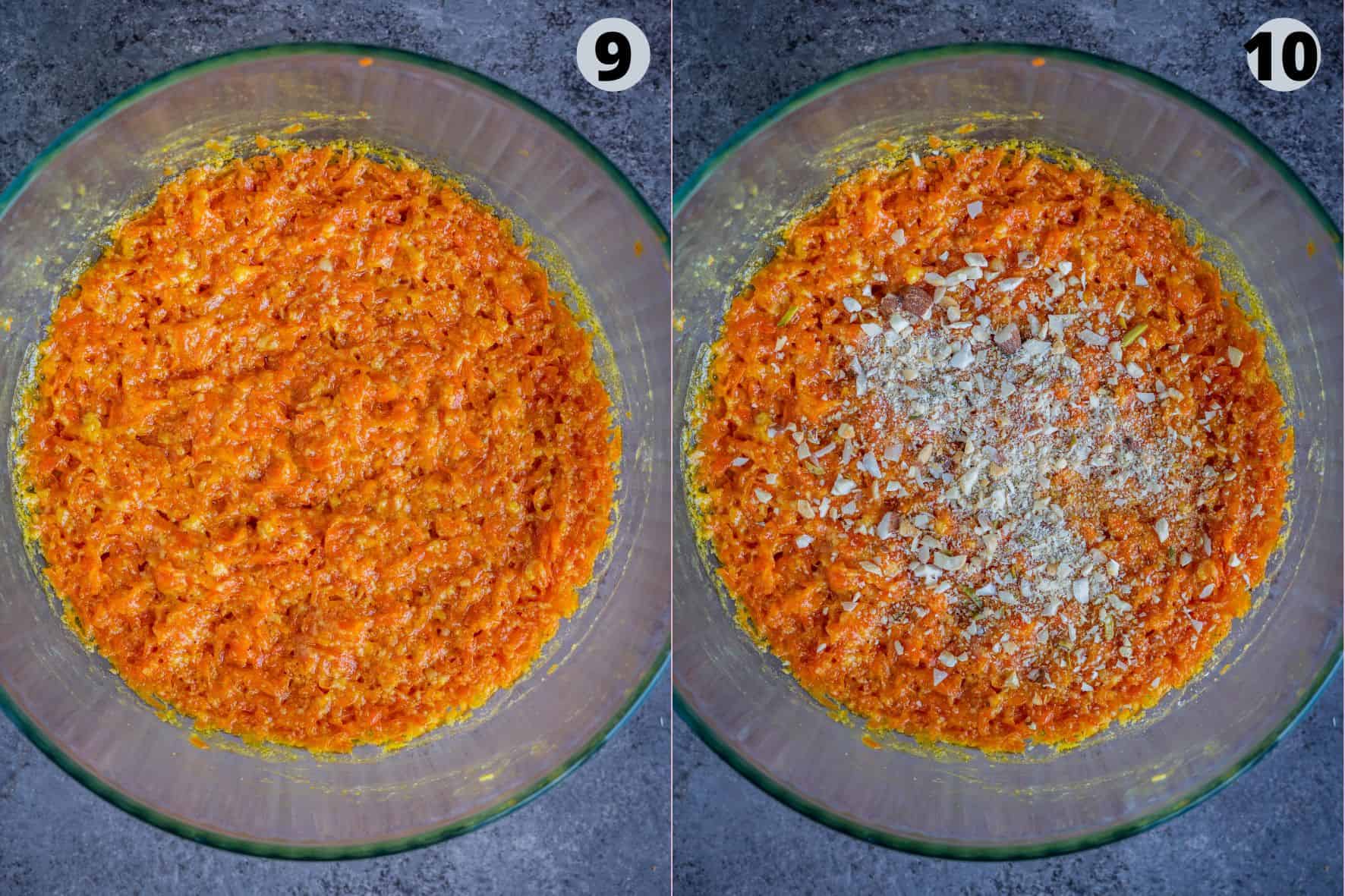
- By now, the carrots should be completely softened, and your microwave carrot halwa will have a luscious, pudding-like consistency-rich, cohesive, and oh-so-inviting. If it still looks a little loose, don't worry. Just microwave it for another 2-3 minutes until it fully comes together.
- Now comes the fun part-garnishing! Sprinkle in a handful of edible rose petals, or chopped nuts like pistachios, almonds, and cashews. For extra crunch and indulgence, I recommend lightly frying the nuts in ghee before mixing them in-it elevates the flavor and makes the dessert feel even more festive. For those extra-special occasions or celebrations like Diwali, I love adding a sheet of silver vark on top of the Gajar ka Halwa. It gives it that traditional, elegant touch you often see in sweet shops.
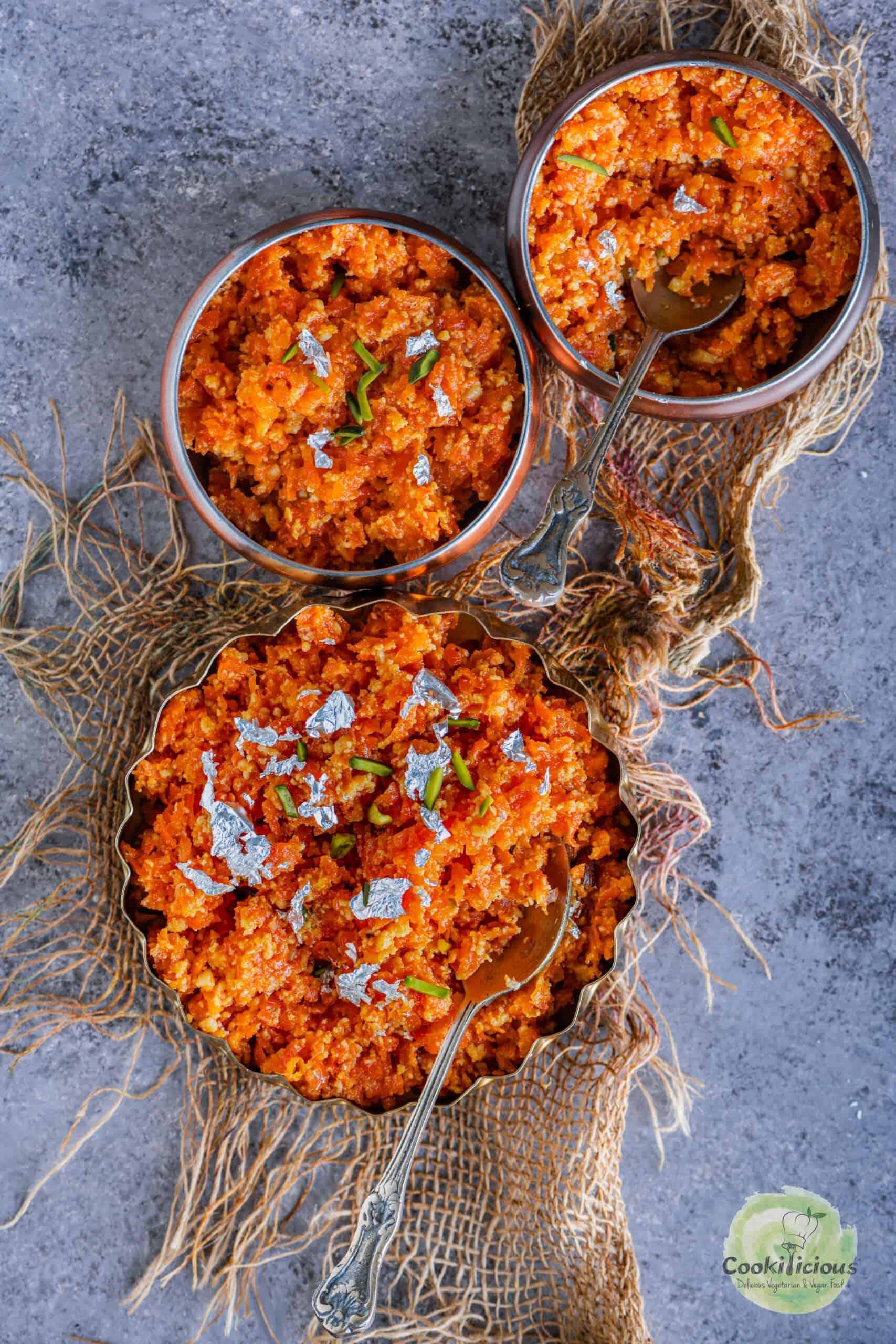
Serving Suggestions 🍽
Let the Gajar ka Halwa rest for a few minutes after cooking-this crucial step allows the pudding to thicken to the perfect consistency and lets all those deep, warm flavors meld beautifully. You can also set the Carrot Halwa in a tray and cut them into desired shapes. Just before serving, drizzle some warm ghee on top for an extra layer of richness.
This authentic Indian dessert can be enjoyed hot or cold, making it incredibly versatile. Serve it warm after a hearty Indian meal for a comforting end, or go bold with a fusion dessert twist by pairing it with vanilla ice cream or rabdi. Either way, it's always a crowd-pleaser.
To me, this Gajar ka Halwa recipe is more than just a sweet treat-it's a bowlful of nostalgia, a symbol of celebration, and a treasured family tradition. Whether you're making it for Diwali, a festive dinner, a party, a potluck, or just because, it's sure to warm your heart and satisfy your sweet tooth.
It also makes a stunning addition to festive thalis and Diwali gift boxes-perfect for sharing a little homemade love and sweetness with friends and family. This Indian dessert can also be consumed during fasting like Navratri.
There are so many fun and creative ways to serve this Indian dessert! Use a portion of this Gajar ka Halwa to make Carrot Halwa Baklava or churn it into a decadent Gajar Halwa Ice Cream. For an elegant dessert, layer it with whipped cream in jars to make Mini Gajar Halwa Cheesecake Jars or Trifles-perfect for parties. You can even shape them into bite-sized Carrot Ladoos and roll them in coconut for a festive twist. The possibilities are deliciously endless!
Popular Desserts Made During Diwali
Here's a delicious collection of traditional and fusion dessert recipes perfect for this Diwali celebration: Rava Ladoo, Shahi Tukda, Karanji Baklava Rolls, Indian Fruit Custard, Gulkand Shrikand Tarts, Chai Cheesecake, Rasmalai Cake, Mango Phirni, Sweet Potato Puran Poli, and Aval Kesari. Whether you want to stick to classic flavors or try something new and exciting, this lineup has something to delight every sweet tooth!
Priya's Recipe Tips 💭
In US, you can check stores like Sprouts, Whole foods, Fresh Market for organic red carrots. You may find them in the farmer's market. If you can't find red carrots, use orange carrots and adjust the sweetness accordingly. Instead of milk, you can also use evaporated milk, heavy cream, creamer or half and half. Just remember, microwave cooking times can vary, so keep an eye on your halwa and stir regularly to ensure even cooking and prevent burning. For Instant pot, dairy-free, and sugar-free carrot halwa recipe, refer to my Vegan Gajar Halwa recipe. Skip adding nuts if you are allergic.
FAQs 📖
For the sweetest and most flavorful Gajar ka Halwa, thin red carrots (often called Delhi carrots) are the best choice due to their natural sweetness and vibrant color. If you can't find them, any good-quality carrot variety will work-just be sure to adjust the sugar to maintain the right sweetness.
When grating, avoid using a very fine grater, as it can make the halwa mushy; a semi-fine grater is ideal for the perfect texture. If you're making a large batch, using a food processor to grate the carrots can save time and ensure uniform pieces, which helps thecarrot pudding cook evenly.
To prepare traditional Gajar ka Halwa on the stovetop, start by cooking freshly grated carrots in a thick-bottomed pan with full-fat milk over medium heat. Stir frequently until the carrots soften and the milk reduces to a thick consistency. Then add pure ghee and sugar (or condensed milk for extra richness), stirring continuously to prevent the mixture from sticking or burning.
Next, fold in grated khoya (mawa) or fresh cream, cooking further until the mixture thickens and the ghee begins to separate and leave the edges of the pan.
Finish by sprinkling aromatic cardamom powder and a handful of chopped nuts such as pistachios, almonds, and cashews.
Serve it for an authentic, comforting Indian dessert experience.
Many home cooks love adding saffron strands soaked in warm milk for a luxurious aroma and vibrant color. A splash of rosewater lends a delicate floral note that elevates this classic Indian dessert. For a subtle warm spice twist, try adding a pinch of nutmeg or cinnamon.
Yes, absolutely! Making Gajar ka Halwa with condensed milk or Milkmaid is a great shortcut for a rich, creamy, and indulgent version. Simply skip the sugar and add condensed milk instead-it sweetens the pudding while also lending a luxurious texture. This method reduces cooking time and adds a caramelized depth of flavor that many love. Just be sure to adjust the quantity to taste, depending on how sweet you like your dessert!
Khoya can be substituted with ricotta cheese. To thicken the gajar ka halwa quickly, add milk powder or almond flour to it. Khoya can be substituted with ricotta cheese. To thicken the gajar ka halwa quickly, add milk powder or almond flour to it. Condensed milk will also give the dessert the desired richness and creaminess.
To store leftover Carrot Halwa (Gajar ka Halwa), let it cool completely and transfer it to an airtight container. Refrigerate for up to 4-5 days. When you're ready to enjoy it again, reheat gently in the microwave or on the stovetop with a splash of milk or a touch of ghee to bring back its rich, creamy texture. For longer storage, Carrot Halwa freezes beautifully-store in freezer-safe containers for up to a month. Just thaw it overnight in the fridge and reheat before serving. This make-ahead Indian dessert is perfect for festive prep or busy weeknights!
If you have leftover khoya, use it to make Khoya Matar.
More Dessert Recipes
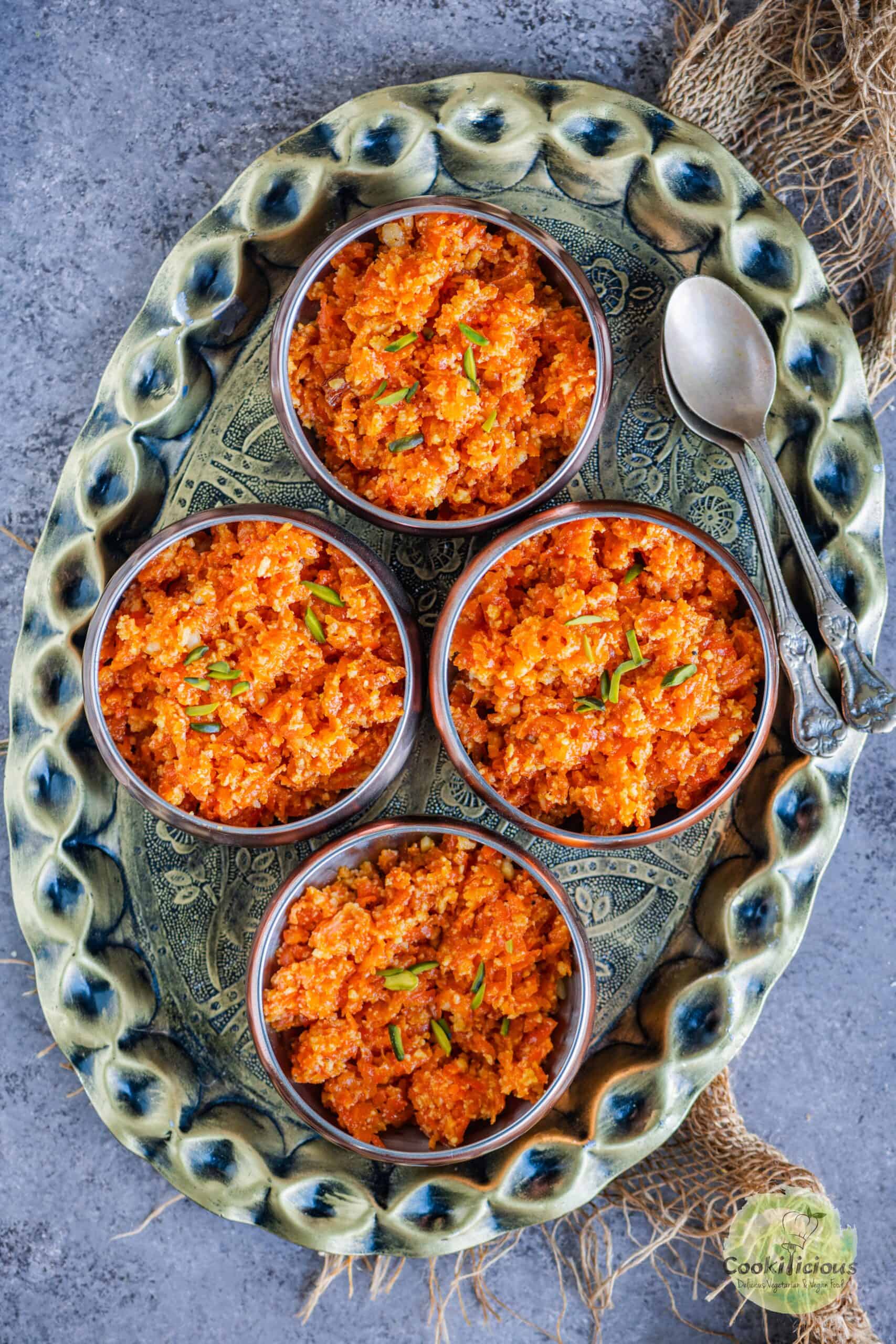
⭐️ Subscribe to the Cookilicious Newsletter and receive new recipes straight to your inbox! You'll receive my FREE Vegan Beginner's guide as a gift. Ready to elevate your cooking game? Purchase my Cookbook - The Essential Vegan Indian Cookbook today!
Recipe 📖
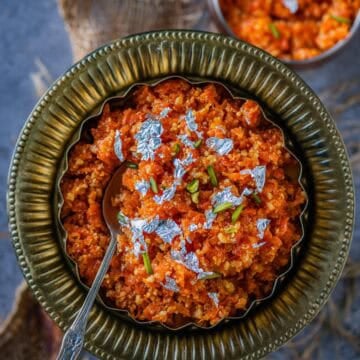
Gajar Ka Halwa Recipe (Carrot Halwa) - Easy Microwave Method
Equipment
Ingredients
- 5 cups grated carrots
- 5 tablespoon ghee
- ½ teaspoon ground cardamom
- 1 cup milk
- ¾ cup sugar
- 6 oz khoya crumbled or grated
- 2 tablespoon mixed chopped nuts
- ½ teaspoon saffron optional
Instructions
- Grate the khoya and keep it ready.
- Peel and grate the carrots.
- Transfer the grated carrots to a microwave safe bowl.
- Add ghee, milk and ground cardamom. Mix. Microwave on HIGH for 15 minutes. Keep stirring every 5 minutes using a silicone spatula. Be careful when dealing with hot bowl. Use pot holders or a towel when taking the hot bowl out of the microwave.
- The carrots will soften after 15 minutes and there will be no liquid left. If not, keep it for 5 more minutes or as needed.
- Then add sugar and microwave on HIGH for another 3 minutes. Again, keep stirring at regular intervals.
- After 3 minutes, the consistency of the halwa will appear liquid. That's fine.
- Add the crumbled khoya to the bowl. Mix well and continue to microwave on HIGH for another 10 minutes. Mix it again halfway. Khoya will help thicken the halwa and give it the right creamy and rich consistency.
- The carrots should have softened by now and come together like a pudding. If not microwave it again for 2-3 minutes.
- Garnish with chopped nuts. Mix and serve.

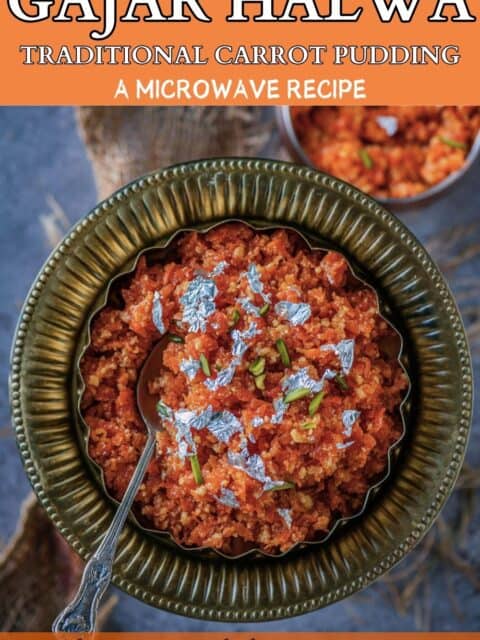



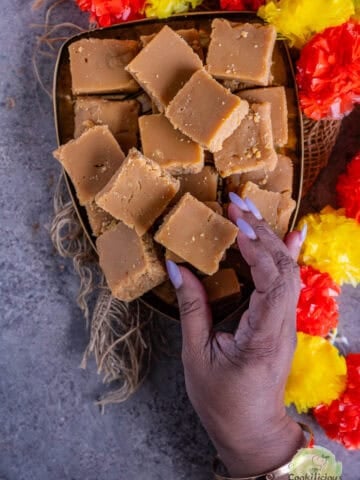
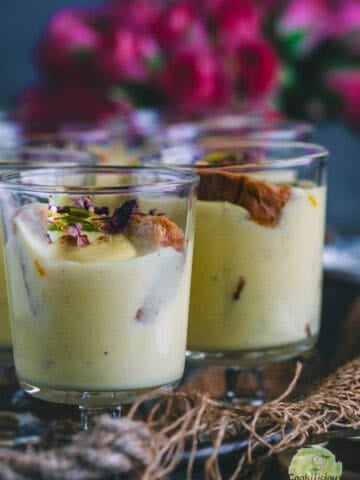
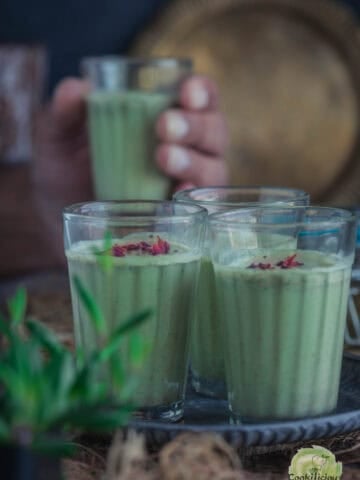

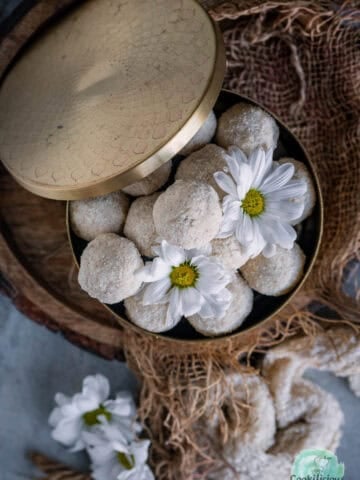
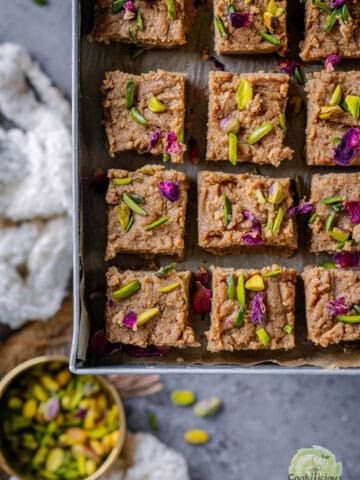

Leave a Reply